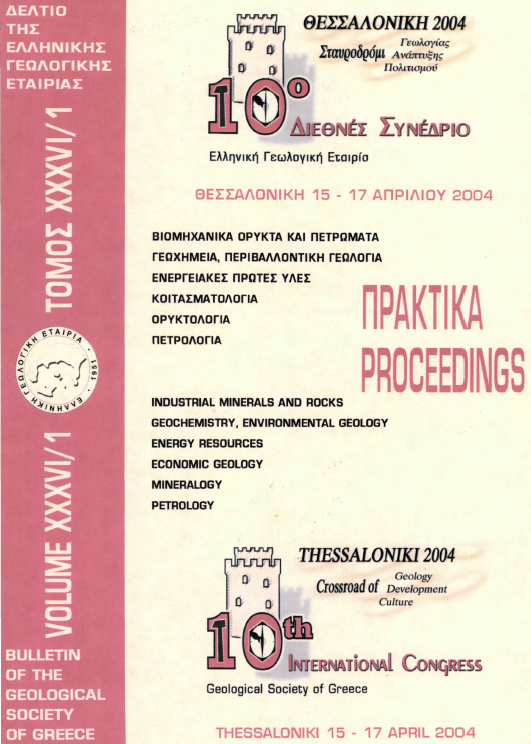Η ΧΡΗΣΗ ΕΠΕΞΕΡΓΑΣΜΕΝΩΝ Ή ΣΥΝΘΕΤΙΚΩΝ ΟΡΥΚΤΩΝ ΣΤΗΝ ΠΑΡΑΣΚΕΥΗ ΤΡΟΦΙΜΩΝ, ΦΑΡΜΑΚΩΝ, ΚΑΛΛΥΝΤΙΚΩΝ ΚΑΙ ΑΛΛΩΝ ΠΡΟΪΟΝΤΩΝ
Περίληψη
Το περιεχόμενο αυτής της εργασίας σχετίζεται με τις βιομηχανίες τροφίμων, φαρμάκων, χημικών προϊόντων (χαρτί, χρώματα, απορρυπαντικά, καλλυντικά) και κατασκευαστικών υλικών. Επιλέχθηκαν δώδεκα διαφορετικά προϊόντα ευρείας κατανάλωσης, ελληνικής ή ξένης προέλευσης, τα οποία αναλύθηκαν για να επιβεβαιωθεί η συμμετοχή κοινών και εξειδικευμένων ορυκτών έστω και σε μικρή αναλογία. Ποσότητες των προϊόντων αυτών θερμάνθηκαν σε 350° C (ή 250° C) για τρεις ώρες, για την καταστροφή των οργανικών συστατικών και την αφαίρεση του νερού και όλων των πτητικών ενώσεων. Το στερεό υπόλειμμα των προϊόντων που εξετάζονται κυμάνθηκε από 10% έως 78%. Παρατηρήθηκε σημαντική μείωση (περίπου κατά 50%) στο στερεό υπόλειμμα των εδώδιμων προϊόντων (σοκολάτα και μπισκότα), όταν θερμάνθηκαν σε διαφορετικές θερμοκρασίες, αλλά ίσης χρονικής διάρκειας, πιθανότατα εξαιτίας της ελλιπούς καύσης των οργανικών συστατικών. Επεξεργασμένα ή συνθετικά ορυκτά αποτελούν το μεγαλύτερο ποσοστό κατά βάρος του απορρυπαντικού πλυντηρίου (78%) και της παιδικής πλαστελίνης (70%). Το στερεό υπόλειμμα αυτών των προϊόντων αποτελείται από ένα έως τέσσερα διαφορετικά ορυκτά. Στη σοκολάτα γάλακτος είναι απροσδιόριστη η παρουσία μιας ανόργανης φάσης στα 3,2 Α και 2,2 Α. Στα μπισκότα (ελληνικής και ισπανικής προέλευσης) διαπιστώθηκε η παρουσία μόνο μιας ανόργανης ουσίας, του αλίτη (αλατιού). To Kaopectate και το Terramin (εμπορικά ονόματα προσθετικών ουσιών με βάση τον καολινίτη και τον Ca-μοντμοριλλονίτη αντίστοιχα), που χρησιμοποιούνται σε ομοειδή τρόφιμα ή φαρμακευτικά δισκία, δεν εντοπίστηκαν, ίσως εξαιτίας της αποσύνθεσης τους κατά τη θερμική κατεργασία των προϊόντων. Η παρουσία κονιοποιημένου ασβεστόλιθου ή μαρμάρου επιβεβαιώθηκε στην τυποποιημένη ορνιθοτροφή, κυρίως με τη συμμετοχή ασβεστίτη και ελάχιστου δολομίτη. Επίσης, σ' αυτήν εντοπίστηκε και ελάχιστη ποσότητα φθορίτη. Ο ανάτασης ως έκδοχο και ο ροδοχρωσίτης ως χρωστική ουσία είναι τα ανόργανα συστατικά των δισκίων του στομάχου (αγγλικής προέλευσης). Ο φθοριοαπατίτης και το διάσπορο είναι οι ορυκτές φάσεις που περιέχονται στην οδοντόκρεμα (ιταλικής προέλευσης) με το πρώτο ορυκτό σε υπερδιπλάσια ποσότητα. Ο ανάτασης και ο τάλκης περιέχονται περίπου σε ίσες ποσότητες στην πούδρα προσώπου (προέλευσης Η.Π.Α.) μαζί με ελάχιστη ποσότητα αιματίτη που δίνει το καστανέρυθρο χρώμα. Συνθετικός ζεόλιθος Α, θειικό νάτριο, ανθρακικό νάτριο και ελάχιστηποσότητα Κ-ούχου αστρίου εντοπίστηκαν στο απορρυπαντικό πλυντηρίου ρούχων. Δεν διαπιστώθηκε η παρουσία τριπολυφωσφορικού νατρίου (STPP). Συνθετικό Τ1Ο2 (από την επεξεργασία ρουτιλίου) είναι το μοναδικό ανόργανο συστατικό του ελαιοχρώματος. Το υπόλειμμα του φωτοτυπικού χαρτιού (σουηδικής προέλευσης) αποτελείται σχεδόν εξολοκλήρου από CaCCb και από μικρή ποσότητα μαρμαρυγία. Τέλος, η παιδική πλαστελίνη αποτελείται κυρίως από ασβεστίτη και μικρές ποσότητες καολινίτη και ορθόκλαστου.
Λεπτομέρειες άρθρου
- Πώς να δημιουργήσετε Αναφορές
-
Τσιραμπίδης Α. (2004). Η ΧΡΗΣΗ ΕΠΕΞΕΡΓΑΣΜΕΝΩΝ Ή ΣΥΝΘΕΤΙΚΩΝ ΟΡΥΚΤΩΝ ΣΤΗΝ ΠΑΡΑΣΚΕΥΗ ΤΡΟΦΙΜΩΝ, ΦΑΡΜΑΚΩΝ, ΚΑΛΛΥΝΤΙΚΩΝ ΚΑΙ ΑΛΛΩΝ ΠΡΟΪΟΝΤΩΝ. Δελτίο της Ελληνικής Γεωλογικής Εταιρείας, 36(1), 53–62. https://doi.org/10.12681/bgsg.16562
- Ενότητα
- Βιομηχανικά Ορυκτά και Πετρώματα

Αυτή η εργασία είναι αδειοδοτημένη υπό το CC Αναφορά Δημιουργού – Μη Εμπορική Χρήση 4.0.
Οι συγγραφείς θα πρέπει να είναι σύμφωνοι με τα παρακάτω: Οι συγγραφείς των άρθρων που δημοσιεύονται στο περιοδικό διατηρούν τα δικαιώματα πνευματικής ιδιοκτησίας επί των άρθρων τους, δίνοντας στο περιοδικό το δικαίωμα της πρώτης δημοσίευσης. Άρθρα που δημοσιεύονται στο περιοδικό διατίθενται με άδεια Creative Commons 4.0 Non Commercial και σύμφωνα με την οποία μπορούν να χρησιμοποιούνται ελεύθερα, με αναφορά στο/στη συγγραφέα και στην πρώτη δημοσίευση για μη κερδοσκοπικούς σκοπούς. Οι συγγραφείς μπορούν να: Μοιραστούν — αντιγράψουν και αναδιανέμουν το υλικό με κάθε μέσο και τρόπο, Προσαρμόσουν — αναμείξουν, τροποποιήσουν και δημιουργήσουν πάνω στο υλικό.




